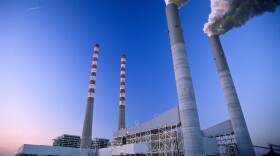-
President Donald Trump granted exemptions last week from some pollution safeguards to dozens of coal- and oil-burning power plants across the country, including four in Kentucky.
-
Industry bill would limit info considered in enforcement actions
-
A recent air monitoring study near a far western Kentucky industrial complex has revealed a rise in harmful emissions and an increased risk of cancer for area residents.
-
Ky.'s Attorney General wrote to the U.S. Environmental Protection Agency on behalf of 14 states to oppose rules that would reduce ozone pollution.
-
State and local officials didn’t begin to inform the public about the widespread PFAS pollution in Henderson until WFPL News and APM Reports broke a series of stories beginning in August.
-
After decades of doing little about the pollution that has plagued much of the country, China's government is temporarily shutting down entire industrial regions to inspect for violations.
-
A new report on U.S. power plant emissions says Kentucky has the highest rate of carbon dioxide emissions in the nation.The report was produced by…
-
The federal government has strengthened the national air quality standard for soot and fine particle pollution. The new standard is 20 percent more stringent than the current standard, which was set in 1997. It will require communities to make sure fine particle pollution is limited to 12 micrograms per cubic meter annually (the current limit is 15). Fine particle pollution, or soot, comes from power plants, refineries, diesel trucks and buses. EPA Administrator Lisa Jackson says the stricter rule will have a major effect on health. “Science shows us that microscopic particles can penetrate deep into the lungs,” she said. “This can lead to a wide range of serious and costly health effects including heart attacks, strokes and aggravated asthma.” Jackson estimates the strengthened standard could provide health benefits worth up to $9 billion by 2020. That’s $170 dollars for each dollar invested in implementing the standard, she says. The only counties that are projected to not meet the new standard by 2020 are in California. Jefferson County isn’t currently meeting the new standard, but is close. Air Pollution Control District spokesman Tom Nord says so far in 2012, the county has only exceeded the new 12 microgram per cubic meter standard twice. A decade ago, particle levels were routinely in the 20s. Nord says he anticipates the county will be in compliance with the new standard within several years. “This is something we’ve been expecting for awhile from the EPA,” he said. “We are going to work with the local community, the business community, to make sure that we can meet this standard; we feel confident that we will.” Nord says he doesn’t expect meeting the new standard to be a “particularly painful” process, but he wasn’t sure by how much upcoming power plant retirements and upgrades will reduce the soot in the community. Louisville’s Cane Run coal-fired power plant is scheduled to be retired and replaced with natural gas by 2016, and the Mill Creek power plant will be updated with new pollution controls. Also playing a role are new fuel standards for vehicles, which will also reduce the amount of soot pollution in the city’s air. Local groups including the Sierra Club, Rubbertown Emergency ACTion, Kentucky Interfaith Power and Light and the Kentucky League of Women Voters applauded the new standard.
-
A three-judge panel has voted two to one to strike down a new rule from the Environmental Protection Agency that would require some states to reduce…
-
Today on NPR: The U.S. government has been tightening the screws on Americans who hide money in offshore accounts, putting pressure on overseas banks, and…
Play Live Radio
Next Up:
0:00
0:00
Available On Air Stations








